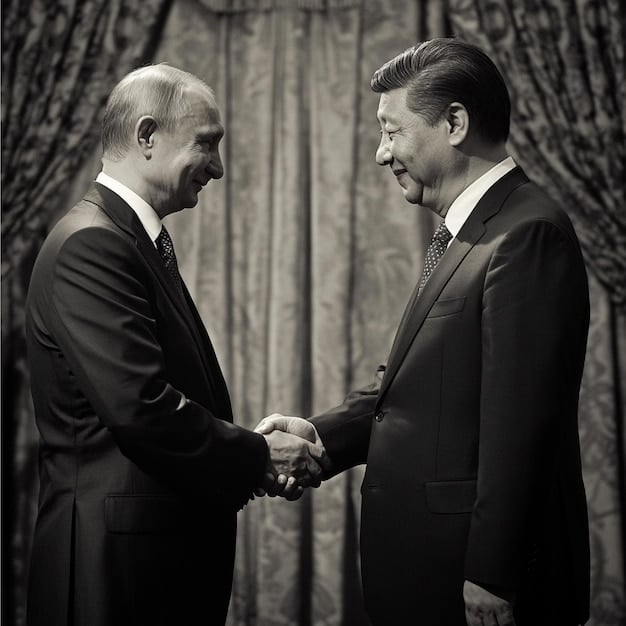US Relations with China: Trade, Security, and Geopolitical Competition

US Relations with China: A Deep Dive into Trade, Security, and Geopolitical Competition examines the multifaceted dynamics between the United States and China, covering economics, military strategy, and global influence.
The relationship between the United States and China is one of the most defining and complex bilateral relationships in the world. US Relations with China: A Deep Dive into Trade, Security, and Geopolitical Competition is essential for understanding the intricacies of their interactions. They are major global players, and the state of their relationship significantly impacts international affairs. This article provides a detailed exploration of their relationships.
Understanding the Historical Context of US-China Relations
To truly grasp the current state of US Relations with China: A Deep Dive into Trade, Security, and Geopolitical Competition, it’s crucial to understand the historical backdrop that has shaped their interactions. The relationship has evolved significantly over the decades, experiencing periods of cooperation, competition, and even confrontation.
Early Interactions and the Cold War Era
The early interactions between the U.S. and China were primarily defined by trade and cultural exchanges. However, the rise of communism in China and the subsequent Cold War dramatically altered the dynamics.
- The Chinese Revolution: The communist victory in 1949 led to the establishment of the People’s Republic of China (PRC) under Mao Zedong.
- The Korean War: The Korean War (1950-1953) saw the U.S. and China on opposing sides, further solidifying their adversarial relationship.
- Taiwan and the One China Policy: The U.S. maintained diplomatic ties with Taiwan (Republic of China) while China viewed Taiwan as a renegade province.
During the Cold War, the United States adopted a policy of containment toward China, viewing it as a major threat to the capitalist world. This period was marked by minimal contact and significant mistrust.

The Nixon Era and the Opening of China
A seismic shift occurred in 1972 when President Richard Nixon made his historic visit to China. This marked the beginning of normalizing relations between the two countries.
Nixon’s visit was driven by a combination of strategic interests, including a desire to counter the Soviet Union and exploit the Sino-Soviet split. The opening of China had profound implications for global geopolitics and trade.
In conclusion, understanding the historical context is vital for appreciating the complexities of US Relations with China: A Deep Dive into Trade, Security, and Geopolitical Competition. The relationship has evolved from early trade interactions to Cold War animosity, and finally, to the normalization of relations under Nixon.
The Economic Dimension: Trade and Investment
The economic relationship between the United States and China is one of the most critical aspects of US Relations with China: A Deep Dive into Trade, Security, and Geopolitical Competition. Trade and investment flows have grown exponentially over the past few decades, creating deep interdependencies, but also significant points of contention.
The Growth of Bilateral Trade
Since China’s economic reforms in the late 1970s, trade between the U.S. and China has exploded. China has become the largest trading partner for the United States.
- Trade Imbalances: The U.S. has consistently run a trade deficit with China.
- Manufacturing Hub: China’s rise as a global manufacturing hub has led to increased exports to the U.S.
- Consumer Benefits: American consumers have benefited from lower prices on goods manufactured in China.
Investment Flows and Economic Interdependence
Investment flows between the U.S. and China are substantial, with significant amounts of U.S. capital flowing into China and vice versa.
This investment has created deep economic interdependence, where both countries have a vested interest in maintaining stable economic relations. However, issues like intellectual property theft and market access barriers remain challenges.
Trade Disputes and Tariffs
Trade disputes have become a prominent feature of US Relations with China: A Deep Dive into Trade, Security, and Geopolitical Competition.
The imposition of tariffs by both countries has had significant impacts on businesses and consumers. These trade disputes reflect deeper concerns about fair trade practices, intellectual property rights, and market access.
Concluding this section, the economic dimension of US Relations with China: A Deep Dive into Trade, Security, and Geopolitical Competition is marked by trade, investment, interdependence, and ongoing disputes over fair trade practices. These factors shape the state of the US-China relationship.
Security and Military Strategy
Security and military strategy form another critical layer in US Relations with China: A Deep Dive into Trade, Security, and Geopolitical Competition. As two major global powers, both countries closely monitor each other’s military capabilities and strategic intentions.
China’s Military Modernization
China has been rapidly modernizing its military, raising concerns in the United States and among its allies.
U.S. Military Presence in the Asia-Pacific
The U.S. maintains a significant military presence in the Asia-Pacific region, including bases in Japan and South Korea.

Flashpoints and Potential Conflicts
Several flashpoints could potentially escalate tensions between the U.S. and China.
- Taiwan: China views Taiwan as a renegade province and has not ruled out using force to reunify it with the mainland.
- South China Sea: China’s territorial claims in the South China Sea have led to disputes with neighboring countries and increased U.S. naval presence.
- Cybersecurity: Cybersecurity issues, including hacking and espionage, have been a persistent source of friction.
The security and military dimensions of US Relations with China: A Deep Dive into Trade, Security, and Geopolitical Competition are characterized by military modernization, strategic competition, and potential flashpoints that could lead to conflict. A commitment to diplomacy and crisis management is vital.
Geopolitical Competition and Global Influence
Geopolitical competition is another crucial aspect of understanding US Relations with China: A Deep Dive into Trade, Security, and Geopolitical Competition. Both countries are vying for influence on the global stage, using different tools and strategies to advance their interests.
The Belt and Road Initiative (BRI)
China’s Belt and Road Initiative is a massive infrastructure development project aimed at connecting Asia, Europe, and Africa through a network of roads, railways, and ports.
U.S. Alliances and Partnerships
The U.S. relies on its network of alliances and partnerships to maintain its global influence.
The U.S. has strong alliances with countries like Japan, South Korea, Australia, and NATO members, which serve as a counterweight to China’s growing influence.
Soft Power and Cultural Influence
Both the U.S. and China employ soft power to enhance their global image and influence.
The U.S. promotes its values through cultural exports, educational programs, and media. China has been expanding its cultural influence through Confucius Institutes and media outreach.
Ultimately, geopolitical competition between the U.S. and China involves the use of both hard and soft power to advance their respective interests and values. Understanding these dynamics is essential for comprehending the larger picture of US Relations with China: A Deep Dive into Trade, Security, and Geopolitical Competition.
Future Prospects and Policy Recommendations
Looking ahead, the future of US Relations with China: A Deep Dive into Trade, Security, and Geopolitical Competition remains uncertain. Several factors will shape the trajectory of their relationship, including domestic politics, economic developments, and geopolitical shifts.
Areas for Cooperation
Despite the competition and tensions, several areas offer potential for cooperation between the U.S. and China.
- Climate Change: Climate change is a global challenge that requires cooperation from all major players, including the U.S. and China.
- Global Health: Global health crises, such as pandemics, require international collaboration and coordination.
- Nuclear Proliferation: Preventing nuclear proliferation is a shared interest of the U.S. and China.
Policy Recommendations
To manage the complexities of the U.S.-China relationship, several policy recommendations can be considered.
Effective management of US Relations with China: A Deep Dive into Trade, Security, and Geopolitical Competition will require a combination of strategic competition, selective cooperation, and sustained dialogue. This approach is vital for ensuring stability and prosperity in the 21st century.
| Key Point | Brief Description |
|---|---|
| 🤝 Historical Context | Evolved from early trade to Cold War hostility. |
| 📈 Economic Ties | Significant trade and investment, with ongoing disputes. |
| 🛡️ Security | Military modernization and potential conflicts in Asia. |
| 🌍 Geopolitics | Global influence and cooperation opportunities. |
Frequently Asked Questions
Key issues include trade imbalances, intellectual property rights, military expansion, and geopolitical influence in regions like the South China Sea.
Trade has created economic interdependence but also disputes over tariffs, market access, and fair trade practices.
Military strategy affects the relationship through concerns over China’s military modernization and U.S. presence in the Asia-Pacific region.
Potential areas for cooperation include climate change, global health, and preventing nuclear proliferation for mutual benefits.
Future developments may include continued competition, selective cooperation, and ongoing dialogues to manage complexities and ensure stability.
Conclusion
In conclusion, understanding US Relations with China: A Deep Dive into Trade, Security, and Geopolitical Competition requires a multifaceted approach. From historical context to economic interdependence, military strategies, and geopolitical competition, several factors shape the trajectory of this vital relationship.





